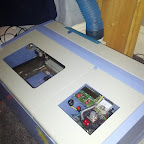K40-III Laser Review
In a few other blog entries, I described getting and modifying my laser cutter/engraver. You can read these here:
- Unboxing
- Modification
- Final touches (coming soon)
This post however is a review on the laser, as it comes from the eBay seller. I’ve broken it into a few sections, and pointed out where my experience has differed from other stories I’ve heard online.
Packaging and Delivery
So, the packaging wasn’t too bad. It was obviously shipped from China, and just redistributed from Portsmouth with no actual unpacking. The outer wooded crate was quite battered and falling apart, with lots of packing tape. Thankfully, inside the crate was lots of polystyrene, and the actual device was in good shape. The x/y carriage was secured with a bit of ribbon, and all electronics were well secured. Now, from various other blogs, I know this was very lucky for me as many other people complain of loose connections and missing screws. About the only complaint I have on the whole packaging front is the way the water cooling tubes were tied in knots. This put some rather bad kinks into the tubing which could restrict the water flow.
Software
The software is the worst part of this device, which is why I threw it away as soon as I’d tested the machine was working. That being said, I can give a few observations from my short lived interaction with it. First off the software is very much Chinese with very basic translations. If you haven’t got the Chinese localisations installed on your computer, then the install process will show lots of strange characters, not that it will be much better unless you can read Chinese. This means installing the software is pretty much blind.
If you manage to stagger through the install process, you’re presented with a whole wealth of configuration options, drop downs, and a big canvas area. At this point, I managed to get one of the example files loaded and the laser tested. After that I didn’t really use the software again. I do know you can import Corel Draw pictures, and possibly even get a plugin of Corel Draw. There are lots of videos on using the software, and if you don’t want to customise the machine, you’re best off watching them.
Laser
Once again, from reading other blogs, I believe that I was rather lucky in that the test fire worked first time. Many other people have to go through an alignment process of tweaking the mirrors or even actually moving the whole laser tube. I can see why they would have these issues as this whole machine isn’t what I’d call well built. Lots of rough edges and no real finish to it in any way, but you get what you pay for. The extractor unit is very basic, and the slot for it is not a good fit. It is well worth taping it into place to get a better seal, and hence better suction to extract the fumes. For cooling you get supplied with a small aquarium pump which needs submerging in a bucket of distilled water to keep the laser cool.
The main area with the x/y axis is actually not too bad, with it all running quite smoothly. The x axis is very slightly out of alignment, which is something I still have to correct, but overall I’m fairly impressed with this. The axis are controlled by standard stepper motors, with endstops being hall effect sensors. The main drawback however is that the cutting area isn’t sealed, so the extractor doesn’t work as well as it should do.
Safety
I think this deserves a section all to itself. This device is built with absolutely no safety features at all. The laser can be running with the lid open to allow people to put their hand in the (invisible) beam of the laser, there are no interlocks either to stop the laser if the water isn’t flowing or the extractor fan fails. I could see no fuses at all within the electronics enclosure, and from one blog I read it was pointed out that some short circuits could put 20kV through to the control panel. Also, the cutting area is not sealed from the electronics area either, so fumes can easily pass through and escape.
Summary
You get what you pay for. This is a very cheap (for laser cutters) machine, with no regard to build quality or safety. If you want to get a laser cutter that works out of the box for commercial reasons, then spend three times more and get something better. That being said, if this is for someone who is technically adept and has experience in cartesian robots such as Reprap or other CNC machines, and wants something to experiment with, this could be a good purchase. My other posts describe what needs to be done to get this working to an acceptable standard, and it will cost a bit more money. I’ve probably spend another 50% on top of the original cost to get it working properly with safety features. If you do go down that route, then this can turn out to be a nice little machine for a hobby or hackspace. Once tuned and tweaked, cutting materials up to 5mm may be possible.
I’m pretty happy with it, and it was a good way to experiment with laser cutters without spending thousands of pounds. I am already thinking about going the entire homebrew route for my next one, if this turns out to be useful for me.
